RENI ALVAREZ COLLECTION
RENI ALVAREZ COLLECTION
CARLOS JURADO
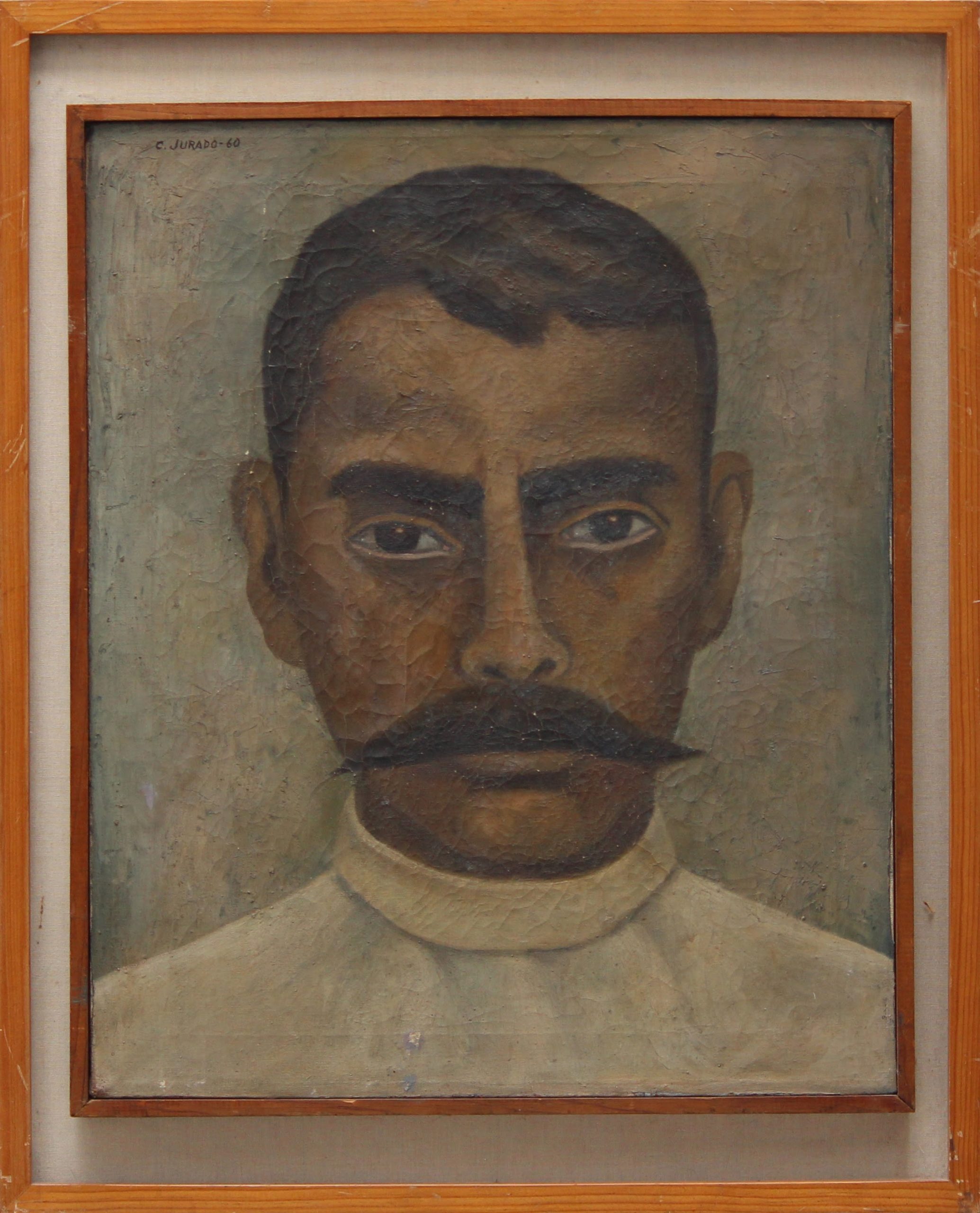
CARLOS JURADO
«RETRATO DE EMILIANO ZAPATA»
SIZE: 57 X 48 CM
OIL ON CANVAS
MÉXICO 1960
CONTACT US FOR PRICING
Carlos Jurado (1927-2019), was a Mexican painter, muralist and photographer whose work was characterised by the experimentation of ancient photographic processes. He is representative of the creation of this type of images and techniques, the result of visionary thinking and an alchemist spirit.In 1944, Carlos Jurado began painting studies at La Esmeralda with prominent teachers such as Antonio Ruiz el Corso, and María Izquierdo. In 1951 he would have his first contact with photography, when he worked for the National Indigenous Institute, visiting indigenous areas of the country producing teaching materials and, three years later, he became a member of the Taller de Gráfica Popular (1954-1959 ).
He held various management positions at the Universidad Veracruzana, where he established, for the first time in Mexico, the photography career as a bachelor’s degree. In 1968, the UNAM organised a retrospective exhibition of his work at the Museo Universitario del Chopo.
«Carlos Jurado: painter, alchemist, photographer, lion and unicorn tamer, an Artist with a capital letter, was, before anything else, a generous man always ready to share knowledge in addition to his creation.»
He was a member of the Taller de la Gráfica Popular and the Salón de la Plástica Mexicana. She has received awards such as the First Prize of the Salon de la Plástica Mexicana, 1953 and the International Biennial of Krakow, in 1978.From 1974 to 1977 he was Director of the Faculty of Plastic Arts of the Veracruzana University in Xalapa and from 1978 to 1983 Director of the Institute of Plastic Arts of the Veracruzana University, Veracruz.
He has exhibited nationally and internationally in countries such as the former Yugoslavia, Cuba, Sweden, Poland or the former Federal Germany.
Carlos Jurado is a strange case of an asynchronous photographer: ahead of his time and, at the same time, archaic. Ahead by becoming a precursor to Lomographic fever. And archaic because in the digital age and mobile devices equipped with a camera, he takes up a photographic technique that dates back to 1850.
It all started in the early 1970s with a «harmless» assignment from his daughter Zinzuni:
“… I remember that he was commissioned to investigate how an image is transmitted inside a dark box and we made a little camera.
I printed the image and, in this way, I was immersed in a fantastic game. «
Her experiments in the manufacture of cameras turned into a most interesting succession of rediscoveries. Jurado learned how to make angle cameras, telephoto cameras, how to incorporate up to three pinholes and even how to create a pinhole camera to take 360º images.
Jurado published in 1974 a book that would become mythical: The art of the apprehension of images and the unicorn.
The pinhole images of Don Carlos were gaining ground and his artistic prestige grew.Pinhole photography is far from being a thing of the past in the new millennium: More than 300 photographers from almost 70 countries participate on World Pinhole Photography Day.
In this world of photography with a cell phone, Facebook and Instagram, Jurado’s images stand out thanks to the visual poeticization that he achieves thanks to photography without a lens.In this era of Post-Photography, the growing value acquired by the work of Carlos Jurado and his «little cardboard cameras» never ceases to amaze.
ABOUT THE PAINTING
Emiliano Zapata Salazar (Anenecuilco, Morelos, August 8, 1879 Chinameca, Morelos, April 10, 1919), also known as El Caudillo del Sur or El Atila del Sur, was a Mexican peasant and military man who participated in the Mexican Revolution as commander of the Liberation Army of the South. Zapata positioned himself as one of the main revolutionary leaders from the presidency of Francisco I. Madero in 1911, until his assassination by orders of Venustiano Carranza in 1919. He is considered a symbol of peasant struggle and resistance in Mexico.
He was an ideologist and promoter of social struggles and agrarian demands, as well as social justice, freedom, equality, social democracy, communal land ownership and respect for the indigenous, peasant and worker communities of Mexico, victims of the oligarchy and the latifundismo of the landowners of the Porfiriato. Although Zapata was excluded, along with Pancho Villa, from the 1917 Constituent Congress, they are responsible for the social constitutionalism that arose from there, especially the article
This portrait represents Carlos Jurado’s stage as a painter when he studied at «La Esmeralda» National School of Painting, Sculpture and Engraving.
The work zapata is one of the few paintings that the master made before dedicating himself fully to photography.
A character like Emiliano Zapata has been an icon to portray. This excellent work captures an elegant and well executed Zapata with colours that represent the Mexican revolution and a background that contrasts with the earth colors of his face.
Carlos Jurado developed a unique and peculiar style in his pictorial work, and Zapata goes a little out of that line to achieve a more realistic result and as a true portrait of the character..
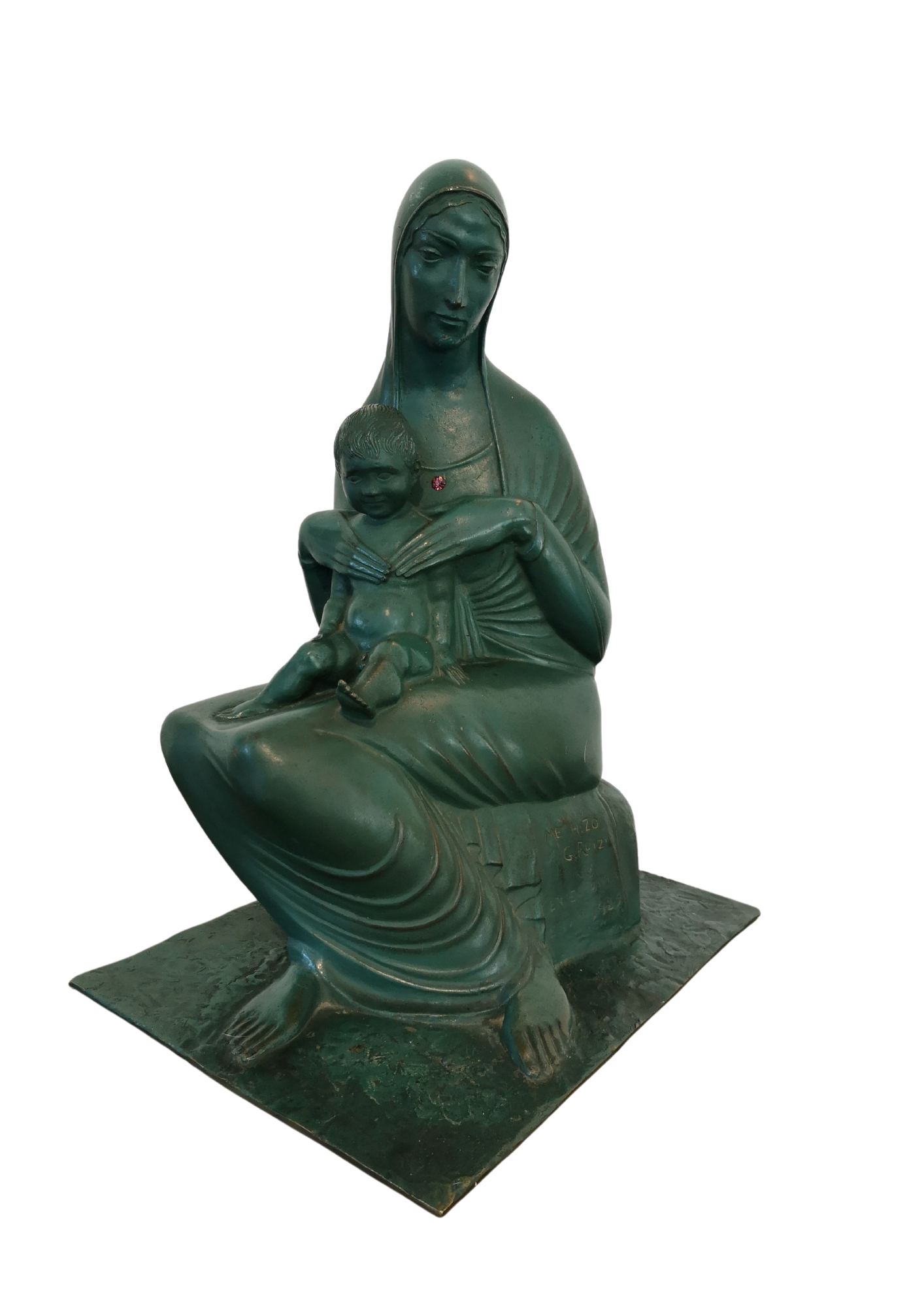
GUILLERMO RUIZ
«MARÍA ANTONIETA RIVAS MERCADO»
47 X 35.5 X 25 CM
BRONZE
YEAR:1925
COUNTRY: SPAIN
CONTACT US FOR PRICING
Contemporary to Asúnsolo, Diego Rivera, Fermín Revueltas, Francisco Centeno, Andrés Romo, Luis Ortiz Monasterio, Saturnino Herrán and Carlos Bracho. From 1922 he participated in different exhibitions, among them the first exhibition organized by the Café de Nadie, of the Estridentista movement, stands out; later he traveled to Europe, where he met the Spanish sculptors José de Creeft and Mateo Hernández. Guillermo Ruiz participated in a definitive way in the renovating start of Mexican sculpture. From his youth, the daring of formal solutions called attention, so around 1922 the poet Manuel Maples Arce, representative of the Estridentistas, mentioned him among the avant-garde artists in Mexico. From the 1930s, Ruiz was he devoted almost exclusively to carrying out monumental public works, representing historical figures.
Guillermo Ruiz Reyes (1894-1965) Founder and director of the Escuela Libre de Escultura y Talla Directa for 15 years (1927-1942) . Author of numerous works found in Michoacán and in other states of the country, carried out in the 30s of the last century. He worked direct stone carving at the beginning of the 20th century, considered the father of such technique in Mexico. He was a disciple of José María Hernández Urbina and José Tovar.
Guillermo Ruiz and Roberto Cueva del Río were the artists before and after the presidential mandate of Lázaro Cárdenas, which is why a large part of this work is in the state of Michoacán, highlighting the 40-meter monument to José María Morelos high in Janitzio, Michoacán, México. Altruistic character and oriented to the education of the generations, he donates a colonial farm in Pinos, Zacatecas, the place of origin for generations of his maternal family to establish the Public Library «Tomasa Reyes Vda. De Ruiz».
Guillermo Ruiz participated in a definitive way in the renewal start of Mexican sculpture. From his youth, the daring of the formal solutions in his works drew attention, in such a way that the poet Manuel Maples Arce, in an interview in 1922, mentioned him among the avant-garde artists in Mexico. And it was not surprising that two
years later he was linked to the Estridentistas group, which in those years was the avant-garde movement par excellence. Starting in the 1930s, Ruiz devoted himself almost exclusively to carrying out monumental public works, representing historical figures. The monumental sculpture of José María Morelos, erected on the island of Janitzio (1933-1935) is one of his most important works and constitutes a unique example, in our country, in terms of its dimensions, formal concept and the scarce technical resources with that were counted for its construction at that time
ABOUT THE SCULPTURE
Antoieta Rivas Mercado was a Mexican intellectual, writer, feminist activist, and arts patron. Borned in Mexico City on April 28, 1900, she was the daughter of architect Antonio Rivas Mercado, the man who designed the Angel of the Independence in México city.
Vasconcelos in 1929, during his presidential campaign. She was quite famous back then but at some point, her work was overshadowed by her status as a patron of Mexican artists. Antonieta Rivas was also known for having funded Mexico’s Symphony Orchestra, along with Carlos Chávez. Antonieta Rivas was allegedly tormented by the fight for the custody of her son, the suicide of her cousin María Remedios Rivas, and her affair with Vasconcelos, who was married. She traveled to France with Vasconcelos and decided to commit suicide at the altar of the Notre Dame cathedral.
According to the Mexican Encyclopedia of Literature, she committed suicide in Notre Dame because of her turbulent life, according to sources, she used a firearm owned by José Vasconcelos, one of the most prominent Mexican writers, philosophers, and politicians. Antonieta Rivas met
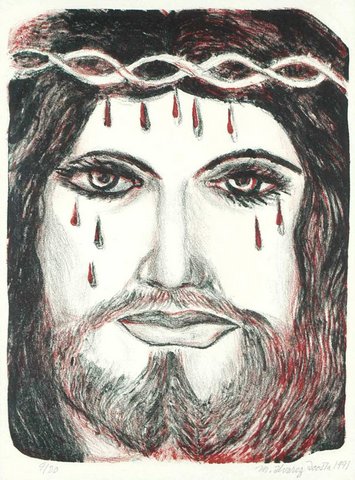
MIGUEL ALVAREZ ACOSTA
» LA CORONA DE CRISTO»
LITOGRAFÍA
USD 400
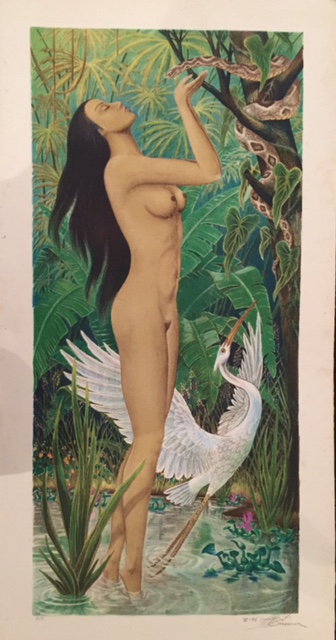
LUIS STREMPLER
«EVA»
Litografía.
CONTACT US FOR PRICING
Luis Strempler was born in 1928 in Mexico City. His career as a painter began at an early age, when he attended the San Carlos Academy with a minimal scholarship to take some drawing classes in the mornings. Likewise, he took some courses at the National School of Plastic Arts, which served to forge his artistic training in drawing and modeling, which allowed him to later experiment with muralism. However, his greatest artistic influence comes from Dr. Atl, who is said to have exchanged experiences on artistic techniques and materials.
During a stay at the Painting and Plastics Workshop of the National Polytechnic Institute, Strempler managed to develop a technique based on acrylic painting through pigmented pastes, and with this creation ROQUERO GÓMEZ, María de la Luz. The painting collection of the National Bank of Mexico. Volume II. Mexico. Banamex Financial Group.
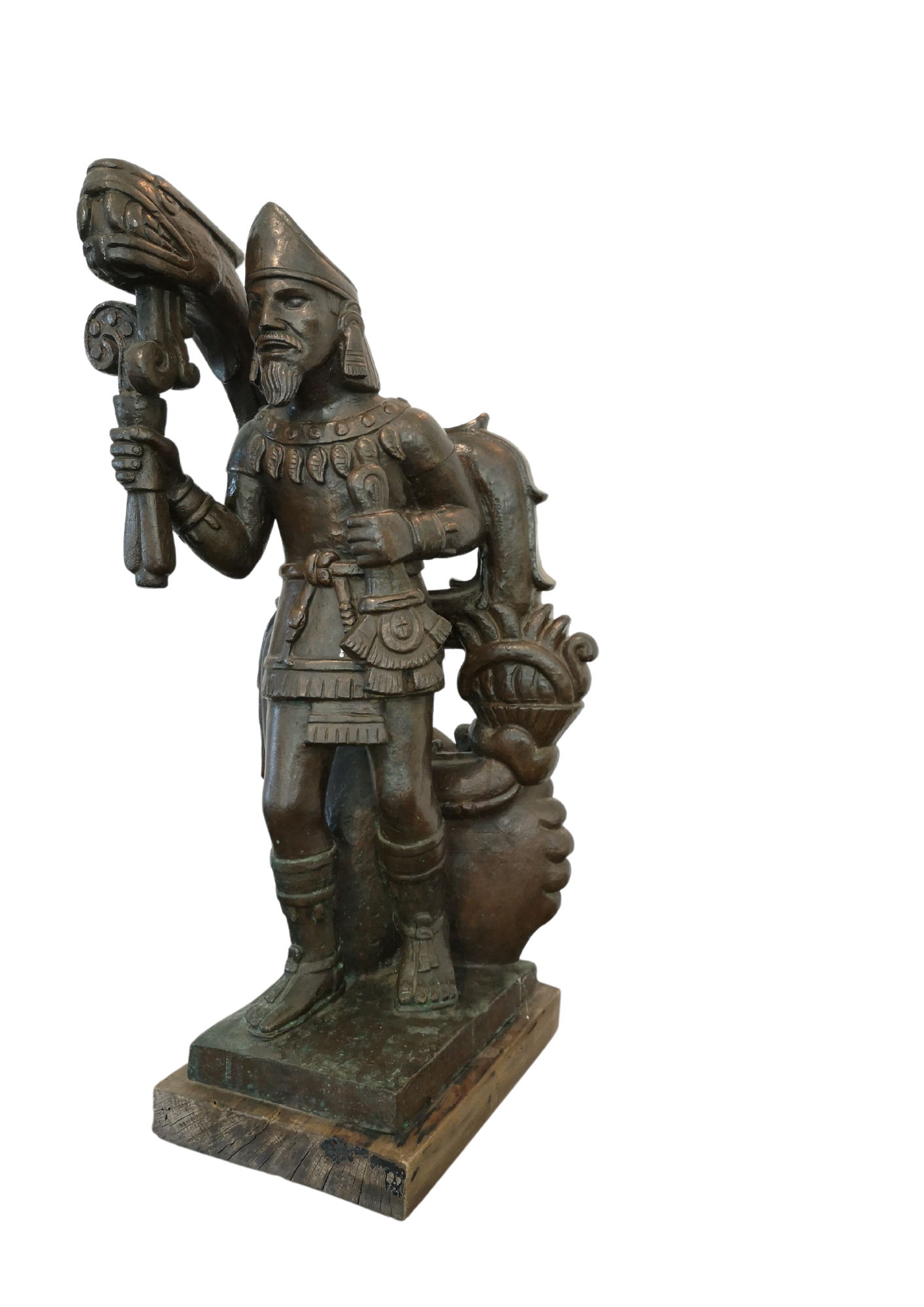
LUIS ORTÍZ MONASTERIO
«QUETZALCOATL»
BRONZ
68 X 34 X 33 CM
CONTACT US FOR PRICING
Luis Ortiz Monasterio (full name Luis Ortiz Monasterio del Campillo) was born in Mexico City, losing his father the year he was born.
In 1920, he spent a year at a teacher’s training course at the Escuela Normal para Maestros while studying drawing at night at the Academy of San Carlos . He later registered as a matriculated student, specializing in engraving, drawing and sculpture.
Because of the family’s economic situation, he went to Los Angeles, where he worked and studied, coming into contact with the works of Auguste Rodin, Brancusi and Wilhem Lehmbruck, In 1927, he participated in a workshop at the Escuela Libre de Escultura y Talla Directa founded by Guillermo Ruiz at the San Ildefonso College , which promoted sculpting Mexican themes and values into native rock.
Ortiz Monasterio retired from his sculpting career in 1989, dying a year later at the age of 83 in Mexico City from multiple natural causes. His body was cremated at the Panteón de Dolores in Mexico City.
With a career that spanned over sixty years, Ortiz Monasterio is one of the main figures of Mexican sculpture in the 20th century. He is one of few to be active during the dominance of the Mexican muralism movement and one of fewer of the century to be remembered.
The artist began his career in 1927 as a drawing teacher at the Escuela de Maestros Contructores of the Secretaria de Educación Públilca, after returned from studies in the United States. He went on to be a long-time teacher of the Escuela Nacional de Artes Plásticas from 1939 to 1962 and taught at La Esmeralda as well.
In 1928, Ortiz Monasterio returned to Los Angeles to sculpt full-time, having his first individual exhibition at the Book Shop Gallery and a later one at Gump’s Art Gallery in San Francisco. In the 1930s he created a number of sculptures which made him known for their originality of form and texture:El soldado herido (1932), La Victoria (1935), El nacimiento de Apolo (1936) and La Venus (1937) . He had two shows at the Galería de Arte Mexicano an at UNAM in 1935 and 1936. In 1946 he participated in the International Sculpture Exhibition at the Philadelphia Art Museum , which acquired a work called Cabeza de mujer (1945). Another piece was acquired by the Museum of Moder Art in New York.
His success in United States brought him back to Mexico, receiving commissions for monumental works. The first of these was El llamado de al revolución in stone, carved between 1932 and 1934. The next in a similar technique, was El esclavo, which has since been lost. Later works include the reliefs for the Benemérita Escuela Nacional de Maestros, the Monumento a los defensores de la ciudad de Puebla (1943), the Monumento a la Madre in Parque Sullivan (1948) the Nezahualcoyotl Fountain in Chapultepec Park, the pórtico for the open air theater of the Plaza Cívica of the Unidad Independencia house complex and the Tigres y Águilas sculpture at the Centro Medico Nacional of IMSS(1963). He also created sculptures for cities such as Xalapa and Acapulco
The first award for his work was a prize in sculpture from the Secretaría de Educación Pública in 1946. In 1967 he received the Premio Nacional de Artes in sculpture. In 1968 he was a founding member of the Academia de Artes and later received a diploma and medal for his teaching career at ENAP. Posthumous tributes include one in 1992 at the OMR Gallery, and a retrospective in 2011 at the Museo Casa Estudio Diego Rivera y Frida Kahlo.
However, since his career, about fifteen percent of his work is missing or destroyed and much of the rest is in deteriorated condition, especially the monumental works.
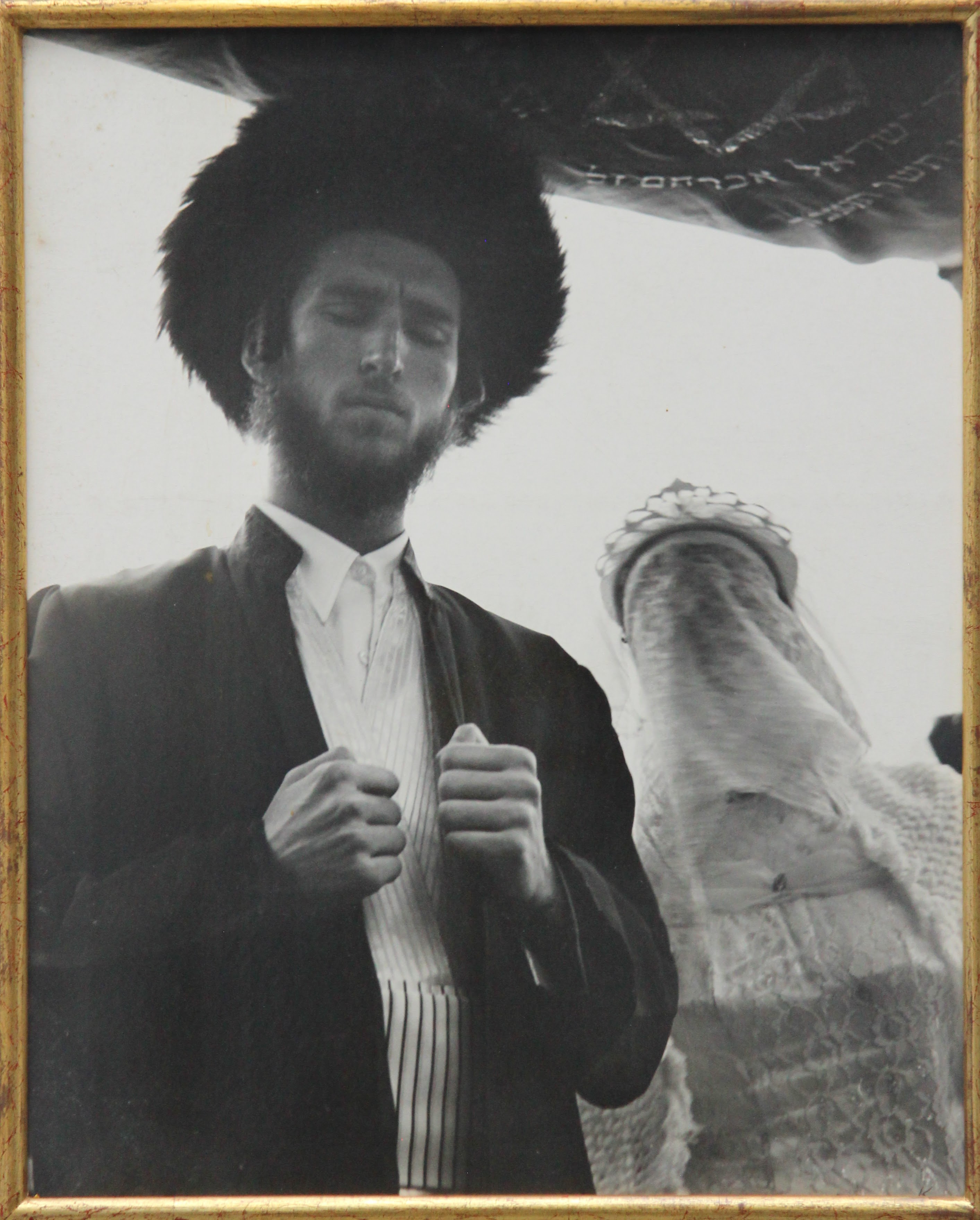
BERNICE KOLKO
«POLISH WEDDING»
48 X 39 CM
PHOTOGRAPHY
CONTACT US FOR PRICING
BERNICE KOLKO (1905–1970) 1905 November 2, born in Grayevo, Poland. The youngest from two brothers and one sister. 1920 The Kolko family emigrates to USA. 1926 She graduates at Crane High School of Chicago and gets married in the same city. 1929 Her son Eugene is born in New York City. 1932 Travels to Europe. At Vienna University, she follows a Photography course with professor Rudolf Koppitz. There is some photographs from that period. 1934 Returns to the United States and works as an independent photographer in New York. 1935 Participates in Collective Exhibition at R.K.O. building, New York as well as the Arts and History Museum in Evansville, Indiana, USA. 1942 Works during Second world war at Lockheed factory, Los Angeles, California. 1944 With a license from the factory she enlists in Women’s Army Corps, as photographer. 1946/7 Lives in Riverside, California. She works in experimental photographic work and follow courses of commercial photography at the Art Center School, Los Angeles, California. She meets Man Ray.
1951 Studies at the Los Angeles City college, Los Angeles, California. Arrives in Mexico in October to spend her holidays. She starts her project Women of Mexico. 1953 Establishes a close friendship with Diego Rivera and Frida Kahlo. Rivera writes a brief text introducing her photographic work. 1955 Bellas Artes National Institute exhibit Women of Mexico, first individual exhibition in Mexico and probably the first woman photographer to exhibit in Bellas Artes, Mexico. She gets close to David Alfaro Siqueiros as well as to Chavez Morado and Olga Costa, painters. 1961 Exhibits Rostros de México (Faces of Mexico) at the Guanajuato University, Guanajuato, Mexico. Travels in Israel and exhibits 122 photographs of Faces of Mexico in Jerusalem, Israel. 1962 The magazine Artes de México dedicates a special number to Markets and Merchants illustrated with her photographs. Travels in Asia: Saigon, Karachi, Birmania, Formosa, India, Thailand and Japan. 1966 Exhibits experimental photography at the gallery of the Mexican American Cultural relations Institute, Mexico City. The University of Mexico publishes her book Faces of Mexico and the Anthropology Institute exhibits The Indian world of Bernice Kolko. Travels in South America: Peru, Ecuador, Bolivia, Brazil, Argentina. 1970 Exhibits Faces of Mexico in Puebla and the Museum of Man in San Diego, California. Dies in Mexico City around December 15 while preparing a trip to South America.

"NACIMIENTO"
UNKNOW ARTIST
1.90 X 100 CM
OIL ON CANVAS
CONTACT US FOR PRICING

ARTE SACRO
UNKNOWN ARTIST AND YEAR
CONTACT US FOR PRICING
TEL
+52 777 112 73 87
CONTACT US
renialvarezcollection@gmail.com
